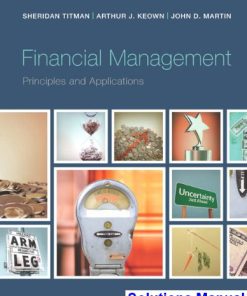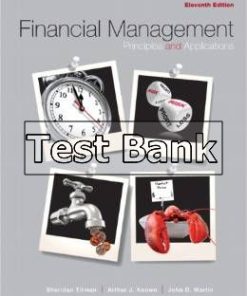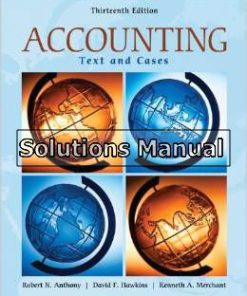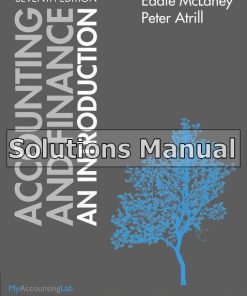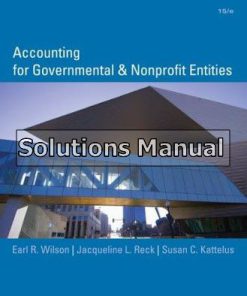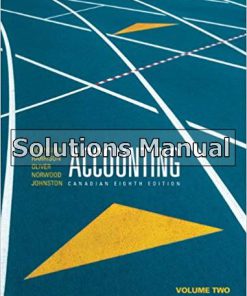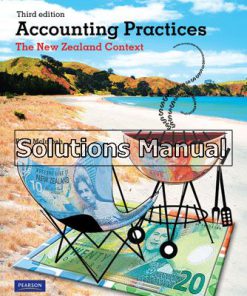Financial Management Principles and Applications 8th Edition Titman Solutions Manual
$26.50$50.00 (-47%)
Financial Management Principles and Applications 8th Edition Titman Solutions Manual.
You may also like
Financial Management Principles and Applications 8th Edition Titman Solutions Manual
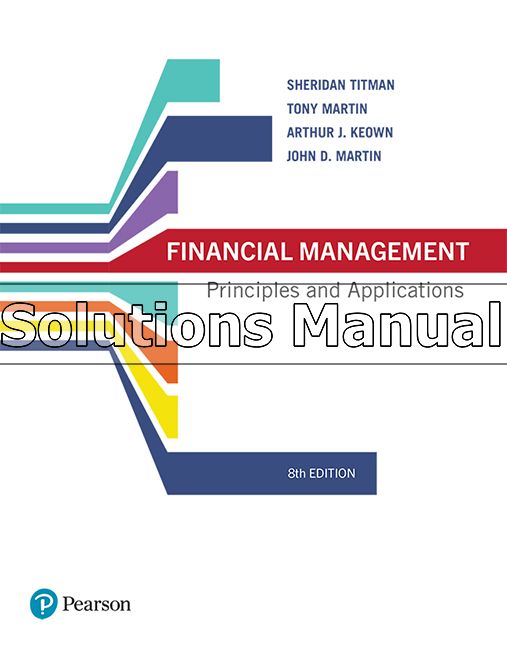
Product details:
- ISBN-10 : 148861721X
- ISBN-13 : 978-1488617218
- Author: Sheridan Titman
Financial Management is a total learning package that reflects the vitality of an ever-expanding discipline, building on the foundations of economics and accounting.
Adapted for the Australian market, students are presented with a cohesive, inter-related subject that they can use when approaching problems. Building on the strengths of the previous edition, this edition refines content, creating a modern teaching approach.
Five key principles are woven throughout the text using multiple teaching methods, forming a rationalised, coherent, integrated and intuitive problem-solving approach.
Table contents:
- Part 1 Introduction to financial management
- Chapter 1 Getting started—Principles of finance
- Finance Spotlight Welcome to the world of finance
- 1.1 Finance: an overview
- What is finance?
- Why study finance?
- 1.2 Three types of business organisation
- Sole proprietorship
- Partnership
- Corporation
- How does finance fit into a firm’s organisational structure?
- 1.3 The goal of the financial manager
- Maximising shareholder wealth
- Ethical considerations in corporate finance
- Finance Spotlight Ethical considerations arising from Bond issues
- 1.4 The five basic principles of finance
- Principle 1: Money has a time value
- Principle 2: There is a risk-return trade-off
- Principle 3: Cash flows are the source of value
- Principle 4: Market prices reflect information
- Principle 5: Individuals respond to incentives
- Chapter summary
- Study questions
- Endnotes
- Chapter 2 Firms and the financial market
- Finance Spotlight Superannuation—defined benefit versus defined contribution
- 2.1 The basic structure of the Australian financial markets
- 2.2 The financial marketplace: financial institutions
- Commercial banks: everyone’s financial marketplace
- Non-bank financial intermediaries
- Investment companies
- Finance Spotlight Controlling costs in managed funds
- 2.3 The financial marketplace: securities markets
- How securities markets bring corporations and investors together
- Types of security
- Stock markets
- Finance Spotlight Where’s the money around the world?
- Financial markets and the Global Financial Crisis (GFC)
- Chapter summary
- Study questions
- Endnotes
- Chapter 3 Understanding financial statements, taxes and cash flows
- 3.1 An overview of the firm’s financial statements
- Finance Spotlight Accounting is the language of business
- Basic financial statements
- Why study financial statements?
- What are the accounting principles used to prepare financial statements?
- 3.2 The income statement
- Income statement of H. J. Boswell Ltd
- Connecting the income statement and the balance sheet
- Interpreting firm profitability using the income statement
- IFRS and earnings management
- Checkpoint 3.1 Constructing an income statement
- 3.3 Corporate tax, personal tax and dividend imputation
- Calculating taxable income and company tax payable
- Personal income tax and capital gains tax
- Checkpoint 3.2 Calculation of personal income tax and capital gains tax
- Dividend imputation
- Checkpoint 3.3 Comparison between a classical tax system and a dividend imputation tax system
- 3.4 The balance sheet
- The balance sheet of H. J. Boswell Ltd
- Firm liquidity and net working capital
- Debt and equity financing
- Checkpoint 3.4 Constructing a balance sheet
- Book values, historical costs and market values
- Finance Spotlight Your personal balance sheet and income statement
- 3.5 The cash flow statement
- Sources and uses of cash
- H. J. Boswell’s cash flow statement
- Finance Spotlight IFRS versus GAAP
- Checkpoint 3.5 Interpreting the statement of cash flows
- Chapter summary
- Study questions
- Study problems
- Mini-case
- Endnotes
- Chapter 4 Financial analysis: sizing up firm performance
- Finance Spotlight Financial ratios and business
- 4.1 Why do we analyse financial statements?
- 4.2 Common-size statements: standardising financial information
- The common-size income statement: H. J. Boswell Ltd
- The common-size balance sheet: H. J. Boswell Ltd
- 4.3 Using financial ratios
- Liquidity ratios
- Checkpoint 4.1 Evaluating James Hardie Industries PLC’s liquidity
- Capital structure ratios
- Asset management efficiency ratios
- Checkpoint 4.2 Comparing the financing decisions of Wesfarmers Ltd and Woolworths Ltd
- Profitability ratios
- Checkpoint 4.3 Evaluating the return on assets for Wesfarmers Ltd and Woolworths Ltd
- Market value ratios
- Finance Spotlight Your cash budget and personal savings ratio
- Checkpoint 4.4 Comparing Treasury Wine Estates with Australian Vintage using market value ratios
- Summing up the financial analysis of H. J. Boswell Ltd
- Finance Spotlight Ratios and international accounting standards
- 4.4 Selecting a performance benchmark
- Trend analysis
- Peer-firm comparisons
- 4.5 Limitations of ratio analysis
- Chapter summary
- Study questions
- Study problems
- Mini-case
- Endnotes
- Part 2 Valuation of financial assets
- Chapter 5 The time value of money—The basics
- Finance Spotlight A dollar saved is two dollars earned
- 5.1 Using timelines to visualise cash flows
- Checkpoint 5.1 Creating a timeline
- 5.2 Compounding and future value
- Compound interest and time
- Compound interest and the interest rate
- Techniques for valuing cash flows at different points in time
- Applying compounding to things other than money
- Checkpoint 5.2 Calculating the future value of a cash flow
- Compound interest with shorter compounding periods
- Checkpoint 5.3 Calculating future values using non-annual compounding periods
- Finance Spotlight Saving for your first house
- 5.3 Discounting and present value
- The mechanics of discounting future cash flows
- Checkpoint 5.4 Solving for the present value of a future cash flow
- Discounting with shorter discounting periods
- Two additional types of discounting problem
- The Rule of 72
- Checkpoint 5.5 Solving for the number of periods, n
- Checkpoint 5.6 Solving for the interest rate, i
- 5.4 Making interest rates comparable
- Calculating the interest rate and converting it to an EAR
- Checkpoint 5.7 Calculating an effective annual rate (EAR)
- To the extreme: continuous compounding
- Chapter summary
- Study questions
- Study problems
- Mini-case
- Chapter 6 The time value of money—Annuities and other topics
- Finance Spotlight Annuities we all know
- 6.1 Annuities
- Ordinary annuities
- Checkpoint 6.1 Solving for an ordinary annuity payment
- Checkpoint 6.2 The present value of an ordinary annuity
- Amortised loans
- Checkpoint 6.3 Determining the outstanding balance of a loan
- Annuities due
- Finance spotlight Saving for retirement
- 6.2 Perpetuities
- Calculating the present value of a level perpetuity
- Checkpoint 6.4 The present value of a level perpetuity
- Calculating the present value of a growing perpetuity
- Checkpoint 6.5 The present value of a growing perpetuity
- 6.3 Complex cash-flow streams
- Checkpoint 6.6 The present value of a complex cash-flow stream
- Chapter summary
- Study questions
- Study problems
- Mini-case
- Chapter 7 Risk and return—An introduction: history of financial market returns
- Finance Spotlight Using statistics
- 7.1 Realised and expected rates of return and risk
- Calculating the realised return from an investment
- Calculating the expected return from an investment
- Measuring risk
- Checkpoint 7.1 Evaluating an investment’s return and risk
- 7.2 A brief history of financial market returns
- Australian financial markets: domestic investment returns
- Lessons learned
- Australian shares versus other categories of investment
- Global financial markets: international investing
- Finance Spotlight Determining your tolerance for risk
- 7.3 Geometric versus arithmetic average rates of return
- Calculating the geometric or compound average rate of return
- Choosing the right ‘average’
- Checkpoint 7.2 Calculating the arithmetic and geometric average rates of return
- 7.4 What determines share prices?
- The efficient markets hypothesis
- Do we expect financial markets to be perfectly efficient?
- Market efficiency: what does the evidence show?
- Chapter summary
- Study questions
- Study problems
- Mini-case
- Endnotes
- Chapter 8 Risk and return—Capital market theory
- Finance Spotlight Risk and your personal investment plan
- 8.1 Portfolio returns and portfolio risk
- Calculating the expected return of a portfolio
- Checkpoint 8.1 Calculating a portfolio’s expected rate of return
- Evaluating portfolio risk
- Calculating the standard deviation of a portfolio’s returns
- Finance Spotlight International diversification
- Checkpoint 8.2 Evaluating a portfolio’s risk and return
- 8.2 Systematic risk and the market portfolio
- Diversification and unsystematic risk
- Diversification and systematic risk
- Systematic risk and beta
- Calculating the portfolio beta
- 8.3 The security market line and the CAPM
- Using the CAPM to estimate expected rates of return
- Checkpoint 8.3 Estimating the expected rate of return using the CAPM
- Chapter summary
- Study questions
- Study problems
- Mini-case
- Endnotes
- Chapter 9 Debt valuation and interest rates
- Finance Spotlight Borrow now, pay later
- 9.1 Overview of government and corporate debt
- Borrowing money in the private financial market
- Borrowing money in the public financial market
- Checkpoint 9.1 Calculating the rate of interest on a floating-rate loan
- Basic bond features
- Finance Spotlight Fixed- and variable-rate mortgages
- 9.2 Valuing bonds
- Valuing bonds by discounting future cash flows
- Step 1: Determine bondholder cash flows
- Step 2: Estimate the appropriate discount rate
- Checkpoint 9.2 Calculating the yield to maturity on a corporate bond
- Step 3: Calculate the present value using the discounted cash flow
- Checkpoint 9.3 Valuing a bond issue
- Checkpoint 9.4 Valuing a bond issue that pays semi-annual interest
- 9.3 Bond valuation: four key relationships
- First relationship
- Second relationship
- Third relationship
- Fourth relationship
- 9.4 Types of bond
- Secured versus unsecured
- Priority of claims
- Initial offering market
- Abnormal risk
- Coupon level
- Amortising or non-amortising
- Convertibility
- Finance Spotlight International bonds
- 9.5 Determinants of interest rates
- Inflation and real versus nominal interest rates
- Checkpoint 9.5 Solving for the real rate of interest
- Interest rate determinants: breaking it down
- Checkpoint 9.6 Solving for the nominal rate of interest
- The maturity-risk premium and the term structure of interest rates
- Chapter summary
- Study questions
- Study problems
- Mini-case
- Endnotes
- Chapter 10 Share valuation
- Finance Spotlight Getting your fair share
- 10.1 Ordinary shares
- Characteristics of ordinary shares
- Finance Spotlight Does a share by any other name smell as sweet?
- Agency costs and ordinary shares
- Valuing ordinary shares using the discounted dividend model
- Checkpoint 10.1 Valuing ordinary shares
- 10.2 The comparables approach to valuing ordinary shares
- Defining the price-earnings (P/E) ratio valuation model
- What determines the P/E ratio for a share?
- Checkpoint 10.2 Valuing ordinary shares using the P/E ratio
- An aside on managing for shareholder value
- A word of caution about P/E ratios
- 10.3 Preference shares
- Features of preference shares
- Valuing preference shares
- Checkpoint 10.3 Valuing preference shares
- A quick review: valuing bonds, preference shares and ordinary shares
- Chapter summary
- Study questions
- Study problems
- Mini-case
- Endnotes
- Part 3 Capital budgeting
- Chapter 11 Investment decision criteria
- Finance Spotlight Making personal investment decisions
- 11.1 An overview of capital budgeting
- The typical capital budgeting process
- What are the sources of good investment projects?
- Types of capital investment project
- 11.2 Net present value
- Why is NPV the right criterion?
- Calculating an investment’s NPV
- Independent versus mutually exclusive investment projects
- Checkpoint 11.1 Calculating the NPV for Project Long
- Checkpoint 11.2 Calculating the equivalent annual cost (EAC)
- 11.3 Other investment criteria
- Profitability index
- Checkpoint 11.3 Calculating the profitability index for Project Long
- Internal rate of return
- Checkpoint 11.4 Calculating the IRR for Project Long
- Checkpoint 11.5 The problem of multiple IRRs for projects
- Modified internal rate of return
- Checkpoint 11.6 Calculating the modified internal rate of return (MIRR)
- Finance Spotlight Higher education as an investment in yourself
- Payback period
- Discounted payback period
- Summarising the alternative decision rules
- 11.4 A glance at actual capital budgeting practices
- Chapter summary
- Study questions
- Study problems
- Mini-cases
- Chapter 12 Analysing project cash flows
- Finance Spotlight The Internet on airline flights—making it happen
- 12.1 Project cash flows
- Incremental cash flows are what matters
- Guidelines for forecasting incremental cash flows
- 12.2 Forecasting project cash flows
- Dealing with depreciation expense, tax and cash flow
- Four-step procedure for calculating project cash flows
- Checkpoint 12.1 Forecasting a project’s operating cash flow
- Calculating project NPV
- 12.3 Inflation and capital budgeting
- Estimating nominal cash flows
- 12.4 Replacement project cash flows
- Category 1: initial outlay, CF0
- Category 2: annual cash flows
- Changes in depreciation and tax
- Changes in working capital
- Changes in capital spending
- Replacement example
- Checkpoint 12.2 Calculating free cash flows for a replacement investment
- Finance Spotlight Entering new markets
- Chapter summary
- Study questions
- Study problems
- Mini-cases
- Appendix: The diminishing value depreciation method
- Study problems
- Endnote
- Chapter 13 Risk analysis and project evaluation
- Finance Spotlight Project risk for entrepreneurs
- 13.1 The importance of risk analysis
- 13.2 Relevant measures of risk in capital budgeting
- Measuring risk for capital budgeting purposes, and a dose of reality—is systematic risk all there
- Finance Spotlight Global strategies to reduce risk
- 13.3 Incorporating risk into the capital-budgeting process
- Risk-adjusted discount rates
- Checkpoint 13.1 Risk-adjusted discount rate
- Certainty-equivalent approach
- Checkpoint 13.2 Certainty equivalents in capital budgeting
- Certainty-equivalent versus risk-adjusted discount rate methods
- Risk-adjusted discount rate and measurement of a project’s systematic risk
- 13.4 Tools for analysing the risk of project cash flows
- Key concepts: expected values and value drivers
- Checkpoint 13.3 Forecasting revenue using expected values
- Sensitivity analysis
- Checkpoint 13.4 Project risk analysis: sensitivity analysis
- Scenario analysis
- Checkpoint 13.5 Project risk analysis: scenario analysis
- Simulation analysis
- Probability trees
- Finance Spotlight Currency risk
- 13.5 Real options in capital budgeting
- The option to delay the launch of a project
- The option to expand a project
- The option to reduce the scale and scope of a project
- Checkpoint 13.6 Analysing real options: option to expand
- Chapter summary
- Study questions
- Study problems
- Mini-case
- Endnote
- Chapter 14 The cost of capital
- Finance Spotlight Understanding the role of the cost of capital
- 14.1 The cost of capital: an overview
- Investor’s required return and the firm’s cost of capital
- WACC equation
- Three-step procedure for estimating the firm’s WACC
- 14.2 Determining the firm’s capital-structure weights
- Checkpoint 14.1 Calculating the WACC for Templeton Extended Care Facilities Ltd
- 14.3 Estimating the cost of individual sources of capital
- The cost of debt
- The cost of preference shares
- The cost of ordinary shares
- Checkpoint 14.2 Estimating the cost of ordinary shares for Qantas Airways Ltd [QAN] using the divide
- Checkpoint 14.3 Estimating the cost of ordinary shares for Qantas Airways Ltd [QAN] using the CAPM
- 14.4 Summing up: calculating the firm’s weighted average cost of capital
- Use market-based weights
- Use market-based opportunity costs
- Use forward-looking weights and opportunity costs
- 14.5 Estimating project costs of capital
- The rationale for using multiple discount rates
- Why don’t firms typically use project costs of capital?
- Estimating divisional WACCs
- Finance Spotlight Why do interest rates differ between countries?
- 14.6 Flotation costs and project NPV
- WACC, flotation costs and NPV
- Checkpoint 14.4 Incorporating flotation costs into the calculation of NPV
- Chapter summary
- Study questions
- Study problems
- Mini-case
- Endnotes
- Part 4 Capital-structure and dividend policy
- Chapter 15 Analysis and impact of leverage
- Finance Spotlight Good debt and bad debt
- 15.1 Business and financial risk
- 15.2 Break-even analysis
- Accounting break-even analysis
- Checkpoint 15.1 Project risk analysis: accounting break-even analysis
- NPV break-even analysis
- Limitations of break-even analysis
- 15.3 Operating and financial leverage
- Operating leverage
- Financial leverage
- Finance Spotlight Fixed operating costs
- Combination of operating leverage and financial leverage
- Checkpoint 15.2 Operating, financial and combined leverage
- Implications of leverage analysis
- 15.4 EBIT–EPS analysis
- Evaluating the effect of financial leverage on firm earnings per share
- Checkpoint 15.3 Evaluating the effect of financing decisions on EPS
- Chapter summary
- Study questions
- Study problems
- Mini-case
- Endnote
- Chapter 16 Capital-structure policy
- Finance Spotlight Capital structure matters to you!
- 16.1 A glance at capital-structure choices in practice
- Defining a firm’s capital structure
- Financial leverage
- How do firms in different industries finance their assets?
- 16.2 Capital-structure theory
- A first look at the Modigliani and Miller capital-structure theorem
- Yogi Berra and the M&M capital-structure theorem
- Capital structure, the cost of equity and the weighted average cost of capital
- Why capital structure matters in reality
- The trade-off theory and the optimal capital structure
- Capital-structure decisions and agency costs
- Making financing choices when managers are better informed than shareholders
- Managerial implications
- 16.3 Why do capital structures differ across industries?
- 16.4 Making financing decisions
- Benchmarking the firm’s capital structure
- Checkpoint 16.1 Benchmarking a financing decision
- Can the firm afford more debt?
- Survey evidence: factors that influence CFO debt policy
- Finance Spotlight Capital structures around the world
- Chapter summary
- Study questions
- Study problems
- Mini-case
- Appendix: Demonstrating the Modigliani and Miller Theorem
- Endnotes
- Chapter 17 Dividend and share-buyback policy
- Finance Spotlight Firms rarely decrease their dividend
- 17.1 How do firms distribute cash to their shareholders?
- Cash dividends
- Share buybacks
- Personal tax considerations: dividend versus capital gains income
- Non-cash distributions: bonus shares and share splits
- 17.2 Does dividend policy matter?
- The irrelevance of the distribution choice
- Checkpoint 17.1 Share price and the timing of dividend payments
- Why dividend policy is important
- Finance Spotlight The importance of dividends
- 17.3 Cash-distribution policies in practice
- Stable payout
- Residual dividend payout policy
- Other factors playing a role in how much to distribute
- Finance Spotlight Dividends at home and abroad
- Chapter summary
- Study questions
- Study problems
- Mini-case
- Endnotes
- Part 5 Liquidity management and special topics in finance
- Chapter 18 Financial forecasting and planning
- Finance Spotlight Developing a financial plan for the firm engages everyone
- 18.1 An overview of financial planning
- 18.2 Developing a long-term financial plan
- Financial forecasting example: Ziegen Ltd
- Finance Spotlight Your personal budget
- Checkpoint 18.1 Estimating discretionary financing needed
- 18.3 Developing a short-term financial plan
- Example cash budget: Melco Furniture Ltd
- Uses of the cash budget
- Chapter summary
- Study questions
- Study problems
- Mini-case
- Chapter 19 Working capital management
- Finance Spotlight Conflicting objectives lead to problems in managing a firm’s working capital
- 19.1 Working capital management and the risk–return trade-off
- Measuring firm liquidity
- Managing firm liquidity
- Risk–return trade-off
- Checkpoint 19.1 Measuring firm liquidity
- 19.2 Working capital policy
- The principle of self-liquidating debt
- A graphic illustration of the principle of self-liquidating debt
- 19.3 Operating cycle and cash conversion cycle
- Measuring working capital efficiency
- Calculating the operating cycle and cash conversion cycle
- Checkpoint 19.2 Analysing the cash conversion cycle
- 19.4 Managing current liabilities
- Calculating the cost of short-term financing
- Evaluating the cost of trade credit
- Evaluating the cost of bank loans
- Checkpoint 19.3 Calculating the APR for a line of credit
- 19.5 Managing the firm’s investment in current assets
- Cash and marketable securities
- Managing accounts receivable
- Finance Spotlight Credit scoring
- Managing inventories
- Chapter summary
- Study questions
- Study problems
- Mini-case
- Endnotes
- Chapter 20 International business finance
- Finance Spotlight Working in a flat world
- 20.1 Foreign exchange markets and currency exchange rates
- What does a change in the exchange rate mean for business?
- Foreign exchange rates
- Checkpoint 20.1 Exchanging currencies
- Types of foreign exchange transaction
- Checkpoint 20.2 Determining the percentage-per-annum premium or discount
- 20.2 Interest-rate and purchasing-power parity
- Interest-rate parity
- Purchasing-power parity and the law of one price
- Finance Spotlight International investing
- The international Fisher effect
- 20.3 Capital budgeting for direct foreigninvestment
- Checkpoint 20.3 International capital budgeting
- Foreign investment risks
- Chapter summary
- Study questions
- Study problems
- Mini-case
- Endnotes
- Chapter 21 Corporate risk management
- Finance Spotlight Welcome to a risky world
- 21.1 Five-step corporate risk-management process
- Step 1: Identify and understand the firm’s major risks
- Step 2: Decide which types of risk to keep and which to transfer
- Step 3: Decide how much risk to assume
- Step 4: Incorporate risk into all the firm’s decisions and processes
- Step 5: Monitor and manage the risks the firm assumes
- 21.2 Managing risk with insurance contracts
- Types of insurance contract
- Why purchase insurance?
- Finance Spotlight Do you need life insurance?
- 21.3 Managing risk by hedging with forward contracts
- Hedging commodity-price risk using forward contracts
- Hedging currency risk using forward contracts
- Checkpoint 21.1 Hedging crude-oil price risk using forward contracts
- 21.4 Managing risk with exchange-traded financial derivatives
- Futures contracts
- Options contracts
- Checkpoint 21.2 Determining the break-even point and profit or loss on a call option
- 21.5 Valuing options and swaps
- The Black–Scholes option pricing model
- Checkpoint 21.3 Valuing a call option using the Black–Scholes model
- Swap contracts
- Credit default swaps
- Chapter summary
- Study questions
- Study problems
- Mini-case
- Endnotes
- Glossary
- Organisation Index
- Subject Index
People also search:
financial management principles and applications 8th edition
financial management principles and applications 13th edition
h financial management
management principles for health professionals 8th edition pdf free
management principles for health professionals 8th edition pdf

